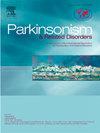Prevalence and incidence of Deep Brain Stimulation and Focused Ultrasound in a cohort of elders with Essential Tremor
IF 3.1
3区 医学
Q2 CLINICAL NEUROLOGY
引用次数: 0
Abstract
Introduction
Deep Brain Stimulation (DBS) and Focused Ultrasound Thalamotomy (FUS) are important surgical alternatives for managing essential tremor (ET). Studies of the prevalence (i.e., the proportion of cases reporting a surgical procedure at a given observation), the incidence (i.e., the proportion of cases reporting new occurrences of a surgical procedure at a given observation), and the surgical rate (i.e., the proportion of cases with no history of surgery who underwent a surgical procedure during a given time interval) of DBS and FUS in ET cases are few and have limitations.
Methods
We obtained surgical histories from 346 ET participants in a longitudinal research study that ascertained cases outside of treatment centers. 283 cases participated in follow-up evaluations at 18, 36, 54, 72 and 90 months (mean length of observation = 4.4 ± 2.5 years).
Results
The cumulative prevalence of DBS and FUS were 0.046 % (Confidence Interval [CI] = 0.024 to 0.068) and 0.035 % (CI = 0.016 to 0.054), respectively. The cumulative incidence (9.44 per 1000 person-years, and 9.43 per 1000 person-years, respectively) and annual surgical rates (0.009, and 0.009, respectively) observed for DBS and FUS were similar. Reported rates for DBS were lower than reported from clinic-based studies.
Conclusion
To date, no other studies have documented the proportion of individuals with ET who have undergone FUS, and only three studies report the proportion who underwent DBS. All of the latter ascertained cases from treatment centers, biasing estimates upwards. Our data add to the understanding of surgical rates for ET.
深部脑刺激和聚焦超声在老年特发性震颤患者中的患病率和发病率
脑深部电刺激(DBS)和聚焦超声丘脑切开术(FUS)是治疗特发性震颤(ET)的重要手术选择。关于脑起搏器和FUS在ET病例中的流行率(即在给定观察期内报告手术的病例比例)、发生率(即在给定观察期内报告新发生手术的病例比例)和手术率(即在给定时间间隔内无手术史的病例比例)的研究很少,而且有局限性。方法我们在一项纵向研究中获得了346名ET参与者的手术史,确定了治疗中心以外的病例。283例患者分别于18、36、54、72、90个月随访,平均观察时间4.4±2.5年。结果DBS和FUS的累积患病率分别为0.046%(置信区间[CI] = 0.024 ~ 0.068)和0.035%(置信区间[CI] = 0.016 ~ 0.054)。DBS和FUS的累积发病率(分别为9.44 / 1000人-年和9.43 / 1000人-年)和年手术率(分别为0.009和0.009)相似。报道的DBS发生率低于基于临床的研究报告。迄今为止,没有其他研究记录了ET患者接受FUS的比例,只有3项研究报告了接受DBS的比例。后者都是从治疗中心确定病例,使估计偏上。我们的数据增加了对ET手术率的理解。
本文章由计算机程序翻译,如有差异,请以英文原文为准。
求助全文
约1分钟内获得全文
求助全文
来源期刊

Parkinsonism & related disorders
医学-临床神经学
CiteScore
6.20
自引率
4.90%
发文量
292
审稿时长
39 days
期刊介绍:
Parkinsonism & Related Disorders publishes the results of basic and clinical research contributing to the understanding, diagnosis and treatment of all neurodegenerative syndromes in which Parkinsonism, Essential Tremor or related movement disorders may be a feature. Regular features will include: Review Articles, Point of View articles, Full-length Articles, Short Communications, Case Reports and Letter to the Editor.
 求助内容:
求助内容: 应助结果提醒方式:
应助结果提醒方式:


